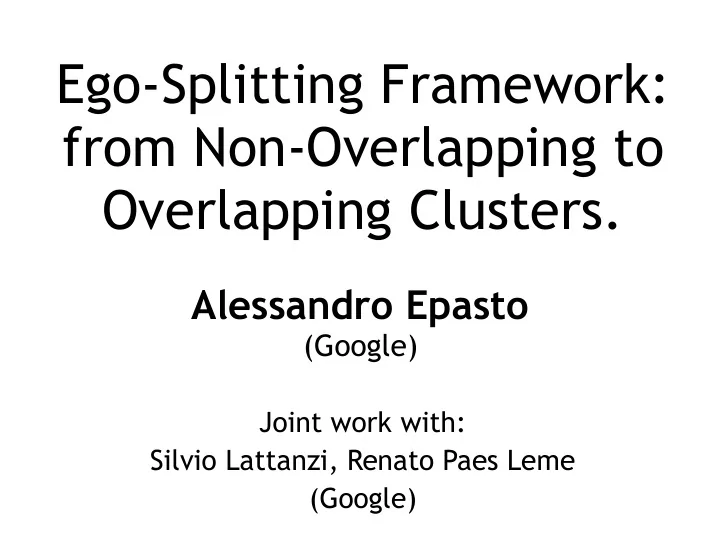

Ego-Splitting Framework: from Non-Overlapping to Overlapping Clusters. Alessandro Epasto (Google) Joint work with: Silvio Lattanzi, Renato Paes Leme (Google)
Community Detection in an Ideal World
Community Detection in an Ideal World Sparse cut Dense communities Disjoint clusters
Community Detection in the Real World Large cut
Community Detection in the Real World Large cut Communities overlap heavily.
Community Detection in the Real World Large cut Communities overlap heavily. More connections with outside than with inside
Global Community Structure Community detection is hard at the global graph level: • No clear macroscopic community structure at global graph level [Leskovec et al., 2009]. • No medium-sized low-conductance communities. • Real-world communities do not follow the assumptions of the algorithms [Abraho et al., 2014]. Intuition: Community structure is clearer at microscopic level of node-centric structures called ego-networks.
Ego-net of
Ego-net of The Ego-net of node u (a.k.a. ego-network ), is defined as the induced subgraph on {u, N(u)}. Similar definition for directed graphs.
Ego-net minus ego of The Egonet minus Ego of node u, is defined as the induced subgraph on {N(u)}. Similar definition for directed graphs.
Intuition Work Family Intuition: while communities overlap, usually there is a single context in which two neighbors interact. This motivates the study of ego-networks for community detection.
Related Work Ego-net based community detection has recent but rich literature: • [Freeman 1982] Definition of ego-net. • [Rees and Gallagher, 2010]. Connected Components in Ego-Nets as communities. • [Coscia et al. 2014], DEMON algorithm. Many follow- ups. • Machine learning based circle detection algorithms (McAuley and Leskovec, 2012). • [Epasto et al. 2016], Ego-net based friend suggestion.
Our Contribution We introduce Ego-Splitting a novel distributed overlapping clustering method: • Highly flexible: turns any non-overlapping algorithm into an overlapping algorithm. • Scalable (tens of billions of nodes and edges). • Provable theoretical guarantees. • Based on a novel graph-theoretic concept of the Persona Graph with potential other applications.
Persona Graph Intuition Work Family Intuition: the red node is actually two nodes which we call persona nodes.
Persona Graph Intuition Work Family Work Family We create a Persona Graph where these two nodes are separated and we split the edges of the original node among the persona nodes.
The Ego-Splitting Framework More formally the Ego-Splitting proceeds in the following steps: • Create the ego-net of each node. • Partition each ego-net with a non-overlapping clustering algorithm A1 • Create the Persona Graph . • Partition the Persona Graph with a non-overlapping clustering algorithm A2 . • Obtain the overlapping clusters of the original graph. The two algorithms A1 and A2 can be arbitrary (and different).
Persona Graph - Example Construction
Persona Graph - Example Construction
Persona Graph - Example Construction Notice that the Persona Graph has the same number of edges.
Persona Graph Formal Definition
Efficient Parallel Ego-Net Construction And Clustering Naive approach O(n^3) just for ego-net construction. [ Epasto et al. VLDB 2016] In 2 M/R steps it is possible to construct and apply any clustering algorithm efficiently on all ego-net with small running time. Intuition: v z The edge u-v is part u of ego-net of z iff u-v-z is a triangle!
Efficient persona graph creation and clustering Based on similar techniques we can show that 4+R rounds of M/R are sufficient to create and cluster the Person Graph with total work of R rounds for the global clustering algorithm, Tl and Tg are the time of the local and global clustering algorithm.
Theoretical Guarantees We study our Ego-Splitting framework in a simple planted overlapping clusters theoretical model. We obtain a graph from the a probabilistic model and learn the original communities.
Probabilistic Model n nodes k communities
Probabilistic Model prob. q n nodes k communities For each node-community pair draw an edges with prob. q
Probabilistic Model prob. p k communities For each community c, and for each pair of nodes u,v in the community draw an edges with prob. p between u and v.
Probabilistic Model k communities prob. p This is equivalent to creating a Gn,p over each community and taking the union of the edges.
Community Reconstruction Problem k communities Given the graph among the nodes, reconstruct the overlapping communities.
Theoretical Guarantees Given a P(n,k,q,p) graph we achieve perfect reconstruction (in the limit) for certain ranges of k,q and p using the simple connected component algorithm for the clustering. Concrete settings: •
Proof Sketch First we prove that each community is connected with high probability also at the level of ego-net of each member.
Proof Sketch Second we prove that if the algorithms makes no mistake at the local clustering stage the community is identified. Finally we show that the mistakes happen in limited number.
Example of Persona Graph 100 nodes 9 overlapping communities The persona graph is visibly easier to cluster with non- overlapping algorithms. Original modularity: 0.25, Persona modularity: 0.6
Empirical Evaluation We used both real-world graphs with up to a tens of billion edges and synthetic graphs with overlapping clusters from a standard benchmark. We evaluated our results on the ground truth clusters using the F1 score and NMI score as in previous work [Coscia et al., 2014]. We compare with the following two other approaches: • DEMON: Coscia et al 2014. • OLP: off-the-shelf overlapping label propagation. • Non overlapping clustering algorithms (not reported).
Results on Synthetic Graphs Our method outperforms all the ones evaluated in F1 and NMI score.
Results on Real-World Graphs Our method outperforms almost all the ones evaluated in F1 and NMI score. Graphs from SNAP library.
Scalability Ratio of wall-clock time w.r.t smallest graph. Our method scales to graphs with billions of nodes and edges.
Conclusions and Future Work It is possible to construct overlapping clusters at scale with provable theoretical guarantees. • Future work: • Other models of computation (dynamic, streaming). • Explore the Persona Graph.
Thank you for your attention Contact: aepasto@google.com www.epasto.org Google NYC Algorithms and Optimization team: research.google.com/teams/nycalg/
Recommend
More recommend